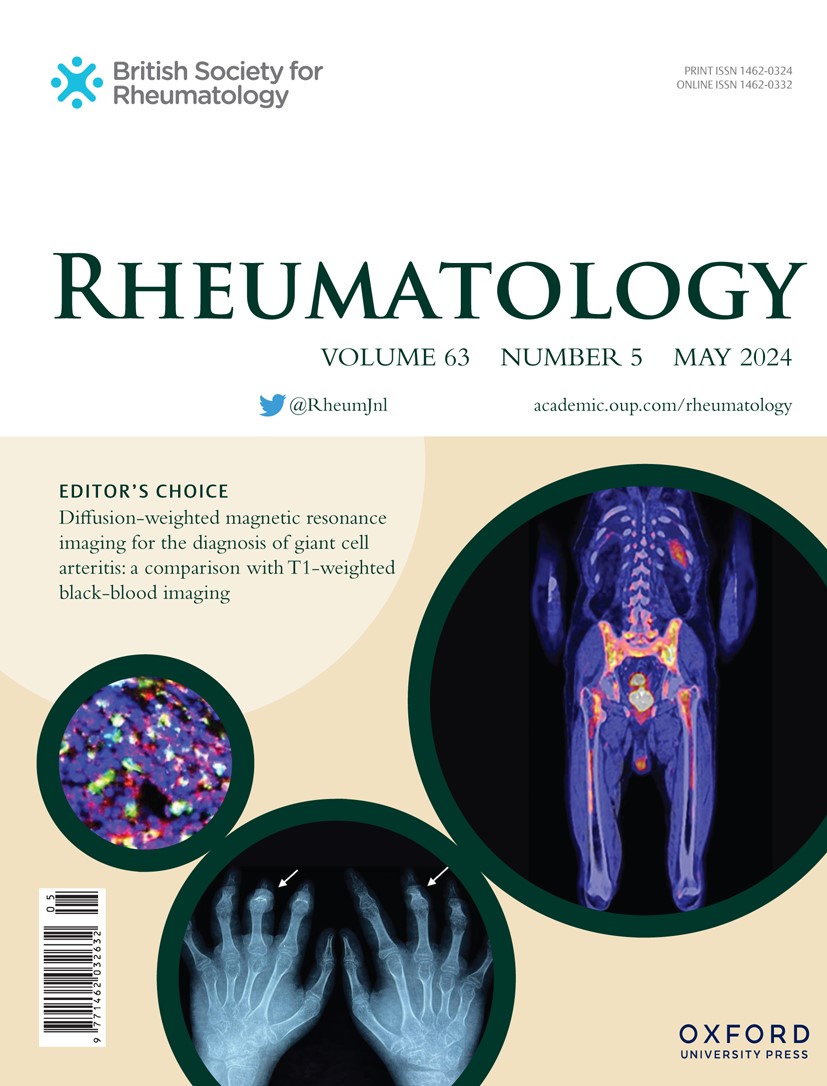CRTAC1:系统性硬化症肺受累的新指标
IF 4.7
2区 医学
Q1 RHEUMATOLOGY
引用次数: 0
摘要
目的间质性肺疾病(ILD)是系统性硬化症(SSc)患者最常见的死亡原因。由肺泡2型上皮细胞分泌的软骨酸性蛋白-1 (CRTAC1)是肺部健康的潜在生物标志物。本研究探讨了CRTAC1在SSc中的作用,重点是肺受累。方法收集76例SSc患者(女性65例,局限性皮肤(lc)SSc: 45例,弥漫性皮肤(dc)SSc: 31例,ILD: 43例,均符合2013年ACR/EULAR标准)和89例健康个体(HC,女性37例)的血浆样本。对患者进行检查和评估,包括欧洲硬皮病研究组(ESSG)活动评分、改良罗德曼皮肤评分(mRSS)、用力肺活量(FVC)、1s用力呼气量(FEV1)、一氧化碳弥散量(DLCO)和Medsger疾病严重程度量表(DSS)。采用CRTAC1 IQ-ELISA (Ray Biotech)检测CRTAC1水平。结果SSc患者血浆中CRTAC1水平较HC患者低(p<;0.001)。伴有ILD的SSc患者与无ILD的SSc患者相比,CRTAC1降低(p= 0.027)。线性模型显示,CRTAC1与DSS肺受累(p= 0.016, β=-2.46)和ESSG活动评分(p= 0.047, β=-2.022)呈负相关,与DLCO (p= 0.065, β= 1.87)、FEV1 (p= 0.1, β= 1.622)和FVC (p= 0.072, β= 1.83)呈正相关。伴有胃肠道(p= 0.002)、关节(p= 0.006)受累和肺动脉高压(p= 0.05)的SSc患者的CRTAC1水平也有所降低。结论:SSc患者全身CRTAC1水平降低,尤其是ILD患者,肺功能降低,疾病活动性升高。我们的研究结果表明,CRTAC1是一种很有希望的SSc肺部受累的生物标志物。本文章由计算机程序翻译,如有差异,请以英文原文为准。
CRTAC1: a novel indicator of lung involvement in systemic sclerosis
Objectives Interstitial lung disease (ILD) is the most frequent cause of mortality in patients with systemic sclerosis (SSc). Cartilage acidic protein-1 (CRTAC1), secreted by alveolar type-2 epithelial cells, is a potential biomarker of lung health. This study explores CRTAC1's role in SSc, focusing on pulmonary involvement. Methods We collected plasma samples from 76 SSc patients (65 females, limited cutaneous (lc)SSc : 45, diffuse cutaneous (dc)SSc : 31, ILD : 43, all fulfilled the 2013 ACR/EULAR criteria) and 89 healthy individuals (HC, 37 females). Patients were examined and assessed for the European Scleroderma Study Group (ESSG) activity score, modified Rodnan skin score (mRSS), forced vital capacity (FVC), forced expiratory volume in 1 s (FEV1), diffusing capacity for carbon monoxide (DLCO) and Medsger Disease Severity Scale (DSS). CRTAC1 levels were measured using the CRTAC1 IQ-ELISA (Ray Biotech). Results CRTAC1 levels in plasma were lower in SSc patients compared with HC (p< 0.001). CRTAC1 was decreased in SSc patients with ILD compared with SSc patients without ILD (p= 0.027). Linear modelling showed negative association of CRTAC1 with DSS pulmonary involvement (p= 0.016, β=-2.46) and ESSG activity score (p= 0.047, β=-2.022), and a positive association with DLCO (p= 0.065, β = 1.87), FEV1 (p= 0.1, β = 1.622) and FVC (p= 0.072, β = 1.83). CRTAC1 levels were also decreased in SSc patients with gastrointestinal (p= 0.002) and joint (p= 0.006) involvement and pulmonary arterial hypertension (p= 0.05). Conclusion Systemic levels of CRTAC1 are decreased in SSc patients, especially among those with ILD, reduced lung function, and elevated disease activity. Our findings establish CRTAC1 as a promising biomarker for pulmonary involvement in SSc.
求助全文
通过发布文献求助,成功后即可免费获取论文全文。
去求助
来源期刊

Rheumatology
医学-风湿病学
CiteScore
9.40
自引率
7.30%
发文量
1091
审稿时长
2 months
期刊介绍:
Rheumatology strives to support research and discovery by publishing the highest quality original scientific papers with a focus on basic, clinical and translational research. The journal’s subject areas cover a wide range of paediatric and adult rheumatological conditions from an international perspective. It is an official journal of the British Society for Rheumatology, published by Oxford University Press.
Rheumatology publishes original articles, reviews, editorials, guidelines, concise reports, meta-analyses, original case reports, clinical vignettes, letters and matters arising from published material. The journal takes pride in serving the global rheumatology community, with a focus on high societal impact in the form of podcasts, videos and extended social media presence, and utilizing metrics such as Altmetric. Keep up to date by following the journal on Twitter @RheumJnl.
 求助内容:
求助内容: 应助结果提醒方式:
应助结果提醒方式:


